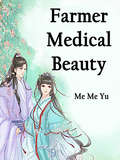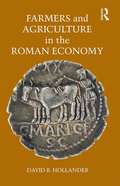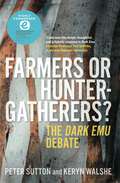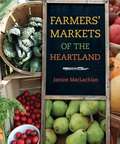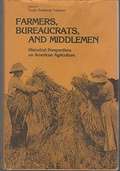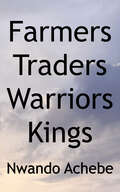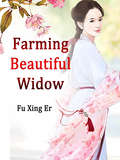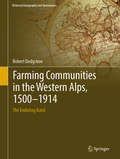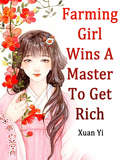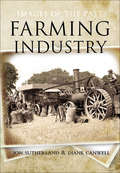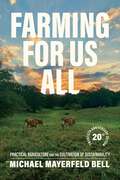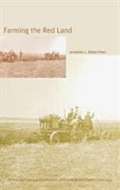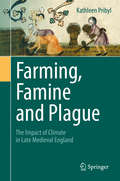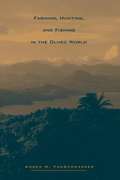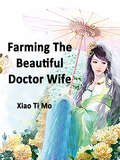- Table View
- List View
Farmer Medical Beauty: Volume 6 (Volume 6 #6)
by Me MeYuIn modern times, female doctors from the jubilant surgery world have lived to ancient times. When they woke up, they were forced by traffickers to jump off cars and faint. Fortunately, they were rescued by their superiors and fell into poverty, entering their homes to sell medicinal herbs and treat minor ailments. By chance, they managed to save the Cold General. The two of them worked together to farm the Boss. See also independent strong, jubilant female doctor, how to cure (change) the straight male cancer late cold face general.
Farmers Unite!: Planting a Protest for Fair Prices
by Lindsay H. MetcalfIn the late 1970s, grain prices had tanked, farm auction notices filled newspapers, and people had forgotten that food didn't grow in grocery stores. So, on February 5, 1979, thousands of tractors from all parts of the US flooded Washington, DC, in protest.Author Lindsay H. Metcalf, a journalist who grew up on a family farm, shares this rarely told story of grassroots perseverance and economic justice. In 1979, US farmers traveled to Washington, DC to protest unfair prices for their products. Farmers wanted fair prices for their products and demanded action from Congress. After police corralled the tractors on the National Mall, the farmers and their tractors stayed through a snowstorm and dug out the city. Americans were now convinced they needed farmers, but the law took longer. Boldly told and highlighted with stunning archival images, this is the story of the struggle and triumph of the American farmer that still resonates today.
Farmers and Agriculture in the Roman Economy
by David B. HollanderOften viewed as self-sufficient, Roman farmers actually depended on markets to supply them with a wide range of goods and services, from metal tools to medical expertise. However, the nature, extent, and implications of their market interactions remain unclear. This monograph uses literary and archaeological evidence to examine how farmers – from smallholders to the owners of large estates – bought and sold, lent and borrowed, and cooperated as well as competed in the Roman economy. A clearer picture of the relationship between farmers and markets allows us to gauge their collective impact on, and exposure to, macroeconomic phenomena such as monetization and changes in the level and nature of demand for goods and labor. After considering the demographic and environmental context of Italian agriculture, the author explores three interrelated questions: what goods and services did farmers purchase; how did farmers acquire the money with which to make those purchases; and what factors drove farmers’ economic decisions? This book provides a portrait of the economic world of the Roman farmer in late Republican and early Imperial Italy.
Farmers or Hunter-gatherers?: The Dark Emu Debate
by Peter Sutton Keryn WalsheAustralians' understanding of Aboriginal society prior to the British invasion from 1788 has been transformed since the publication of Bruce Pascoe's Dark Emu in 2014. It argued that classical Aboriginal society was more sophisticated than Australians had been led to believe because it resembled more closely the farming communities of Europe. In Farmers or Hunter-gatherers? Peter Sutton and Keryn Walshe ask why Australians have been so receptive to the notion that farming represents an advance from hunting and gathering. Drawing on the knowledge of Aboriginal elders, previously not included within this discussion, and decades of anthropological scholarship, Sutton and Walshe provide extensive evidence to support their argument that classical Aboriginal society was a hunter-gatherer society and as sophisticated as the traditional European farming methods. Farmers or Hunter-gatherers? asks Australians to develop a deeper understanding and appreciation of Aboriginal society and culture.
Farmers' Markets of the Heartland
by Janine MaclachlanIn this splendidly illustrated book, food writer and self-described farm groupie Janine MacLachlan embarks on a tour of seasonal markets and farmstands throughout the Midwest, sampling local flavors from Michigan, Ohio, Indiana, Illinois, Missouri, Iowa, Minnesota, and Wisconsin. She conducts delicious research as she meets farmers, tastes their food, and explores how their businesses thrive in the face of an industrial food supply. She tells the stories of a pair of farmers growing specialty crops on a few acres of northern Michigan for just a few months out of the year, an Ohio cattle farm that has raised heritage beef since 1820, and a Minnesota farmer who tirelessly champions the Jimmy Nardello sweet Italian frying pepper. Along the way, she savors vibrant red carrots, slurpy peaches, vast quantities of specialty cheeses, and some of the tastiest pie to cross anyone's lips. Informed by debates about eating local, seasonal crops, organic farming, sanitation, and biodiversity, Farmers' Markets of the Heartland tantalizes with special recipes from farm-friendly chefs and dozens of luscious color photographs that will inspire you to harvest the homegrown flavors in your own neighborhood.
Farmers, Bureaucrats, and Middlemen: Historical Perspectives on American Agriculture (National Archives conferences #17)
by Trudy Huskamp PetersonAgriculture... The Largest Interest of the Nation, The National Archives and the Study of Agricultural History, Agricultural Leadership: Bureaucrats and Organizers, Agricultural Labor: The Dark Side of the Agrarian Myth, Agricultural Research and Development: Progress, Problems, and Paradox, Directions in Domestic Marketing, The Federal Government and Twentieth-Century Agriculture.
Farmers, Traders, Warriors, and Kings: Female Power and Authority in Northern Igboland, 1900-1960 (Social History of Africa Series)
by Nwando AchebeThis is a brilliant and refreshing book, which gives ample and well-deserved voice to women...It is a book that will definitely be of interest to scholars and students in the fields of history, anthropology, political science, religion, and political economy. It is a must read for scholars and students in Women''s Studies Programs.
Farming Beautiful Widow: Volume 3 (Volume 3 #3)
by Fu XingErOnce passed through, became Xitang village by the family sink of the literary talent, broken house three rooms, family walls, no land. Wenxiu looked at her hungry son and daughter, then gritted her teeth and rolled up her sleeves. She searched for food, picked herbs, sold delicacies, bought land, and lived past the red blaze. However, the long-lost ghost suddenly came back, and Wen Xiu's smile blossomed.
Farming Beautiful Widow: Volume 4 (Volume 4 #4)
by Fu XingErOnce passed through, became Xitang village by the family sink of the literary talent, broken house three rooms, family walls, no land. Wenxiu looked at her hungry son and daughter, then gritted her teeth and rolled up her sleeves. She searched for food, picked herbs, sold delicacies, bought land, and lived past the red blaze. However, the long-lost ghost suddenly came back, and Wen Xiu's smile blossomed.
Farming Beautiful Widow: Volume 5 (Volume 5 #5)
by Fu XingErOnce passed through, became Xitang village by the family sink of the literary talent, broken house three rooms, family walls, no land. Wenxiu looked at her hungry son and daughter, then gritted her teeth and rolled up her sleeves. She searched for food, picked herbs, sold delicacies, bought land, and lived past the red blaze. However, the long-lost ghost suddenly came back, and Wen Xiu's smile blossomed.
Farming Beautiful Widow: Volume 6 (Volume 6 #6)
by Fu XingErOnce passed through, became Xitang village by the family sink of the literary talent, broken house three rooms, family walls, no land. Wenxiu looked at her hungry son and daughter, then gritted her teeth and rolled up her sleeves. She searched for food, picked herbs, sold delicacies, bought land, and lived past the red blaze. However, the long-lost ghost suddenly came back, and Wen Xiu's smile blossomed.
Farming Communities in the Western Alps, 1500–1914: The Enduring Bond (Historical Geography and Geosciences)
by Robert DodgshonThis monograph explores traditional farming communities in French-speaking areas of the western Alps for the period 1500-1914 and how they endured in such an environment despite the many problems and risks which it posed for their subsistence and welfare. Using an extensive amount of archival material drawn from the relevant regional archives, the book presents a great deal of fresh data. Its central theme is how such communities responded to the opportunities and challenges presented by the highly variegated environment of their setting. The view taken is that their strategies of exploitation stressed diversity and flexibility, mapping the highly varied ecologies and resource opportunities of their setting into these strategies by spreading livelihood and risk as widely as possible. This interpretative framework is developed across all the book's themes: landholding, arable and livestock sectors, use of the commons and, finally, how communities coped with climate-based risks.The book appeals to geographers, historians, environmental scientists and everyone interested in traditional farming communities and their long-term challenges.
Farming Girl Wins A Master To Get Rich: Volume 1 (Volume 1 #1)
by Xuan Yithe person chosen by the witch clan's forbidden spell for a thousand years ji shuang shuang had turned from a modern criminal police into an ancient peasant girl when she woke up ji shuang shuang opened the gate of fate on the other hand if he could gather spiritual herbs and raise snakes then he would find mines and dig up jade he would have to make a fortune along the way unexpectedly i was just on my way when i was kidnapped by a mute han to be my daughter-in-law mother did you just escape from the zhu family's dog's mouth did you just turn around and fall back into the den of wolves
Farming Girl Wins A Master To Get Rich: Volume 2 (Volume 2 #2)
by Xuan Yithe person chosen by the witch clan's forbidden spell for a thousand years ji shuang shuang had turned from a modern criminal police into an ancient peasant girl when she woke up ji shuang shuang opened the gate of fate on the other hand if he could gather spiritual herbs and raise snakes then he would find mines and dig up jade he would have to make a fortune along the way unexpectedly i was just on my way when i was kidnapped by a mute han to be my daughter-in-law mother did you just escape from the zhu family's dog's mouth did you just turn around and fall back into the den of wolves
Farming Girl Wins A Master To Get Rich: Volume 3 (Volume 3 #3)
by Xuan Yithe person chosen by the witch clan's forbidden spell for a thousand years ji shuang shuang had turned from a modern criminal police into an ancient peasant girl when she woke up ji shuang shuang opened the gate of fate on the other hand if he could gather spiritual herbs and raise snakes then he would find mines and dig up jade he would have to make a fortune along the way unexpectedly i was just on my way when i was kidnapped by a mute han to be my daughter-in-law mother did you just escape from the zhu family's dog's mouth did you just turn around and fall back into the den of wolves
Farming Girl Wins A Master To Get Rich: Volume 4 (Volume 4 #4)
by Xuan Yithe person chosen by the witch clan's forbidden spell for a thousand years ji shuang shuang had turned from a modern criminal police into an ancient peasant girl when she woke up ji shuang shuang opened the gate of fate on the other hand if he could gather spiritual herbs and raise snakes then he would find mines and dig up jade he would have to make a fortune along the way unexpectedly i was just on my way when i was kidnapped by a mute han to be my daughter-in-law mother did you just escape from the zhu family's dog's mouth did you just turn around and fall back into the den of wolves
Farming Industry: Images Of The Past (Images of the Past)
by Diane Canwell Jon SutherlandWorking with prestigious archives of contemporary photographs, the authors chart the history of Britain's farming heritage with 120 rarely seen photographs. Nearly eleven thousand years ago humans moved away from hunting and gathering and began to raise livestock and plant crops. Our nostalgia for the way the countryside had been is an enduring passion. Ultimately mechanization began to replace more traditional forms of farming, and the Industrial Revolution was drawing more and more people away from the fields. Photography emerged at a crucial time when farming tasks could be done with a speed and on a scale previously unimaginable. Farming history has been driven by experimentation, innovation, and invention. The 19th century was one of those times marked by such change. This book looks at that pivotal period in history after which the British countryside would never be the same.
Farming for Us All: Practical Agriculture and the Cultivation of Sustainability (Rural Studies)
by Michael Mayerfeld BellClimate change. Habitat loss. Soil erosion. Groundwater depletion. Toxins in our food. Inhumane treatment of farm animals. Increasing farm worker exploitation. Hunger and malnutrition in the midst of plenty. What will it take for farmers in the United States to embrace sustainable practices?Michael Mayerfeld Bell’s Farming for Us All first tackled this question twenty years ago, providing crucial insight into how the structure of US agriculture created this situation and exploring, by contrast, the practices of farmers who are working together to radically change how they think, learn, and grow. This updated edition of his now-classic work reflects on the lessons learned over the past two decades.Constrained by an oppressive nexus of markets, regulations, subsidies, and technology, farmers find themselves undermining their own economic and social security as well as the security of the land. Bell turns to Practical Farmers of Iowa (PFI), that state’s largest sustainable-agriculture group. He traces how PFI creates an agriculture that engages others—farmers, researchers, officials, and consumers—in a common conversation about what agriculture could look like. Through dialogue, PFI members crossbreed knowledge, discovering pragmatic solutions to help crops grow in ways that sustain families, communities, societies, economies, and environments.Farming for Us All makes the case that for sustainable farming to flourish, new social relations are as important to cultivate as new crops. This book is necessary—and hopeful—reading for anyone concerned about the present and future of food and farming.
Farming in Carroll County
by Lyndi McnultyCarroll County's road signs are a testament to the farm families who settled here. Bollinger, Hoff, Roop, Baugher, Royer, Bushey, and many more are road names that honor those who have produced food for themselves and the nation in times of peace, war, and the Great Depression. In 1917, when the first county agricultural agent arrived, 96.6 percent of the land was held in 3,384 farms. By 1926, Carroll County, Maryland, led the state in corn, swine, and poultry production. It was second in dairy and beef, and it was the world leader in wormseed oil production. A prominent feature of Carroll County's landscape has always been the red barns, and they still are today. The photographs in this book were collected from farm families and historical organizations, portraying a unique insider's view of the history of farm life in Carroll County.
Farming in the 1920s and 30s
by Jonathan BrownAfter answering the call to feed the nation during the First World War, the farmer of the 1920s had to settle down to a peace time of low prices for his produce. A new generation of farmers and workers had to face the challenges of farming in recession. How they did so is the focus of this book - the changes on the farm of the 1920s and 1930s: what it produced and where, the new techniques and machines for a new age.
Farming the Red Land: Jewish Agricultural Colonization and Local Soviet Power, 1924-1941
by Jonathan L. Dekel-ChenThis is the first history of the Jewish agricultural colonies that were established in Crimea and Southern Ukraine in 1924 and that, fewer than 20 years later, ended in tragedy. Jonathan Dekel-Chen opens an extraordinary window on Soviet rural life during these turbulent years, and he documents the remarkable relations that developed among the American-Jewish sponsors of the ambitious project, the Soviet authorities, and the colonists themselves. Drawing on extensive and largely untouched archives and a wealth of previously unpublished oral histories, the book revises what has been understood about these agricultural settlements. Dekel-Chen offers new conclusions about integration and separation among Soviet Jews, the contours of international relations, and the balance of political forces within the Jewish world during this volatile period.
Farming, Famine and Plague
by Kathleen PribylThis book is situated at the cross-roads of environmental, agricultural and economic history and climate science. It investigates the climatic background for the two most significant risk factors for life in the crisis-prone England of the Later Middle Ages: subsistence crisis and plague. Based on documentary data from eastern England, the late medieval growing season temperature is reconstructed and the late summer precipitation of that period indexed. Using these data, and drawing together various other regional (proxy) data and a wide variety of contemporary documentary sources, the impact of climatic variability and extremes on agriculture, society and health are assessed. Vulnerability and resilience changed over time: before the population loss in the Great Pestilence in the mid-fourteenth century meteorological factors contributing to subsistence crises were the main threat to the English people, after the arrival of Yersinia pestis it was the weather conditions that faciliated the formation of recurrent major plague outbreaks. Agriculture and harvest success in late medieval England were inextricably linked to both short term weather extremes and longer term climatic fluctuations. In this respect the climatic transition period in the Late Middle Ages (c. 1250-1450) is particularly important since the broadly favourable conditions for grain cultivation during the Medieval Climate Optimum gave way to the Little Ice Age, when agriculture was faced with many more challenges; the fourteenth century in particular was marked by high levels of climatic variability.
Farming, Hunting, and Fishing in the Olmec World
by Vanderwarker Amber M.In this book, Amber VanDerwarker conducts the first multidisciplinary analysis of subsistence patterns at two Olmec settlements to offer a fuller understanding of how the development of political complexity was tied to both agricultural practices and environmental factors.
Farming: Volume 1 (Volume 1 #1)
by Xiao TiMoModern medicine students forget the heart, once dressed into an ancient peasant girl. Initially, he only wanted to make a fortune through his medical skills, but he didn't expect that he would have to fight a hooligan and outdo a shrew. Although the situation was unsatisfactory, it was a good thing that the medicinal field, the opening of a medical clinic, and the passing of days! Shen Cangxin, set a small goal and fight for it … Woo! Woo! Envy, good girl. First, earn a child. Shen Wansan:?
Farming: Volume 10 (Volume 10 #10)
by Xiao TiMoModern medicine students forget the heart, once dressed into an ancient peasant girl. Initially, he only wanted to make a fortune through his medical skills, but he didn't expect that he would have to fight a hooligan and outdo a shrew. Although the situation was unsatisfactory, it was a good thing that the medicinal field, the opening of a medical clinic, and the passing of days! Shen Cangxin, set a small goal and fight for it … Woo! Woo! Envy, good girl. First, earn a child. Shen Wansan:?
